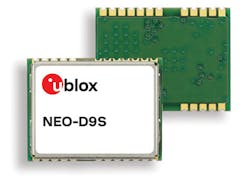In its NEO-D9S GNSS (Global Navigation Satellite System) correction-data receiver module, u-blox offers an affordable approach to centimeter-level accuracy in GNSS receivers. The NEO-D9S module receives GNSS correction data from correction service providers broadcast on the L-band (1525-1559 MHz). A host processor can then decrypt this correction data and deliver it to a high-precision GNSS receiver, combining corrections directly with readings from the satellite constellations to enable much more accurate position readings than those offered by GNSS signals alone.
Use of the NEO-D9S will also increase the availability of high-precision GNSS positioning data in areas with limited connectivity and reduce the amount of cellular data consumed by positioning receivers. Applications include automotive and OEM industrial-system integrators that offer position-correction services, and any other applications that rely on very accurate positioning at low cost.
The NEO-D9S module is a correction-only receiver based on u-blox’s 9th-generation (D9) platform. Thus, it will integrate easily with the company’s F9 RTK GNSS receivers, or it can become part of a modular product roadmap. The module also integrates a TCXO and SAW filter to ensure good RF sensitivity and resistance to interference from adjacent channels.
The module includes the algorithms necessary to decode satellite data broadcasts. Though configured to work initially with whichever correction service has been set as default, it can be configured for any L-band data broadcast. Configuration settings are stored in non-volatile memory.


